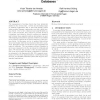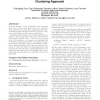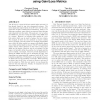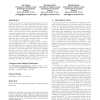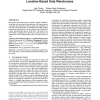GIS
2005
ACM
15 years 3 months ago
2005
ACM
When integrating geo-spatial datasets, a join algorithm is used for finding sets of corresponding objects (i.e., objects that represent the same real-world entity). Algorithms for...
111
click to vote
GIS
2005
ACM
15 years 3 months ago
2005
ACM
The management of moving objects has been intensively studied in the recent years. A wide and increasing range of database applications has to deal with spatial objects whose posi...
107
click to vote
GIS
2005
ACM
15 years 3 months ago
2005
ACM
Numerous raster maps are available on the Internet, but the geographic coordinates of the maps are often unknown. In order to determine the precise location of a raster map, we ex...
111
click to vote
GIS
2005
ACM
15 years 3 months ago
2005
ACM
Recent research literature on sensor network databases has focused on finding ways to perform in-network aggregation of sensor readings to reduce the message cost. However, with t...
108
click to vote
GIS
2004
ACM
15 years 3 months ago
2004
ACM
Personal gazetteers record individuals' most important places, such as home, work, grocery store, etc. Using personal gazetteers in location-aware applications offers additio...
117
click to vote
GIS
2004
ACM
15 years 3 months ago
2004
ACM
Grid is a promising e-Science infrastructure that promotes and facilitates the sharing and collaboration in the use of distributed heterogeneous resources through Virtual Organiza...
103
click to vote
GIS
2004
ACM
15 years 3 months ago
2004
ACM
The R*-tree is a state-of-the-art spatial index structure. It has already found its way into commercial systems. The most important improvement of the R*-tree over the original R-...
125
click to vote
GIS
2004
ACM
15 years 3 months ago
2004
ACM
Spatial, temporal and spatio-temporal aggregates over continuous streams of remotely sensed image data build a fundamental operation in many applications in the environmental scie...
112
click to vote
GIS
2004
ACM
15 years 3 months ago
2004
ACM
Spatial co-location patterns represent the subsets of events whose instances are frequently located together in geographic space. We identified the computational bottleneck in the...
104
click to vote
GIS
2004
ACM
15 years 3 months ago
2004
ACM
Motivated by the increasing need to handle complex multidimensional data in location-based data warehouses, this paper proposes a powerful data model that is able to capture the c...

